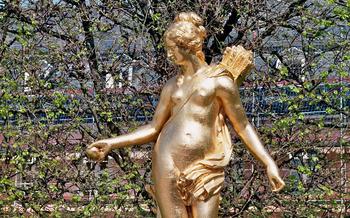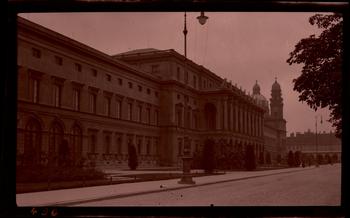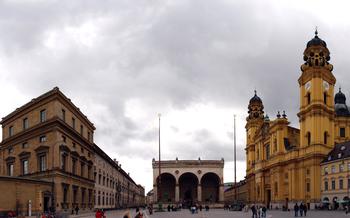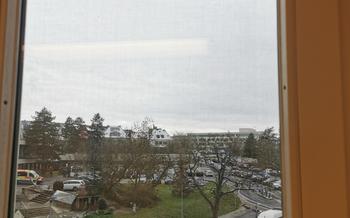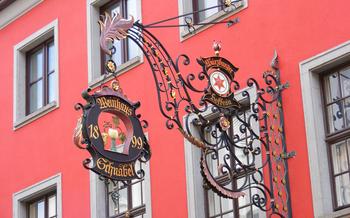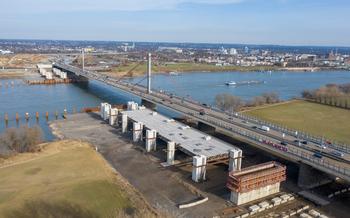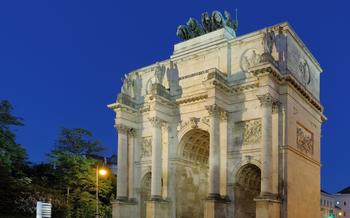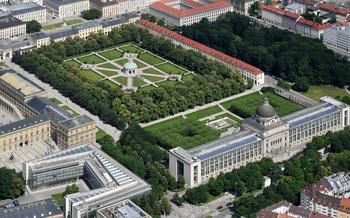
Hofgarten
- Hofgarten: A Majestic Oasis in Würzburg
- Baroque Splendor: The Garden's Design
- A Walk Through Time: Exploring the Garden
- The Grand Fountain: A Centerpiece of Majesty
- Sculptures and Statues: A Gallery in Nature
- The Orangery: A Haven for Exotic Plants
- The Mirror Pond: Reflections of Beauty
- The Hedge Maze: A Verdant Labyrinth
- The Court Garden: A Private Retreat
- The Garden Festivals: A Celebration of Nature
- The Garden's Role in Local Life
- Visiting Tips for a Memorable Experience
- Respecting the Garden's Heritage
- Insider Tip: Discovering Hidden Gems
Hofgarten: A Majestic Oasis in Würzburg
Nestled in the heart of Würzburg, the Hofgarten (Court Garden) stands as a testament to the city's rich history and love for nature. Its origins date back to the 18th century when Prince-Bishop Johann Philipp Franz von Schönborn commissioned the creation of a magnificent garden that would rival the grand gardens of Versailles and Schönbrunn. With its meticulous design, intricate sculptures, and vibrant plant life, the Hofgarten has become an iconic landmark of Würzburg, attracting visitors from around the world.
Conveniently located within the city center, the Hofgarten is easily accessible by foot, public transportation, or car. Its proximity to other major attractions, such as the Residenz and the Old Main Bridge, makes it an ideal starting point for exploring Würzburg's cultural treasures. The garden serves as a tranquil oasis amidst the bustling city, offering a welcome respite from the urban environment.
Baroque Splendor: The Garden's Design
The Hofgarten's design showcases a blend of French and Italian influences, resulting in a geometric layout and symmetrical design. The garden's central axis, stretching from the main entrance to the Grand Fountain, bisects the space, creating a sense of order and balance. This formal structure is further enhanced by the intricate patterns of the flower beds, the manicured hedges, and the carefully placed trees.
Ornate fountains and sculptures adorn the garden, adding a touch of grandeur and artistry. The Grand Fountain, located at the end of the main axis, serves as the garden's centerpiece, while other smaller fountains and statues are scattered throughout the grounds, providing focal points and adding to the visual interest of the garden.
A Walk Through Time: Exploring the Garden
Entering the Hofgarten through its main gate, visitors are greeted by a grand vista, a central axis that leads the eye directly towards the magnificent fountain. This main path, adorned with meticulously manicured hedges, symmetrical flower beds, and imposing statues, serves as the spine of the garden's layout. Along this axial route, visitors encounter a series of notable features that showcase the garden's design and artistry.
At the heart of the garden, the Grand Fountain stands as a testament to Baroque grandeur, its cascading waters and allegorical sculptures capturing the attention of all who behold it. Flanking the fountain are two symmetrical parterres, their intricate patterns created using colorful flowers, boxwood hedges, and crushed stone. These intricate designs, reminiscent of tapestries woven from nature's palette, add a touch of elegance and visual interest to the garden.
As visitors continue their stroll along the main path, they discover hidden gems tucked away amidst the lush greenery. Secluded corners offer respite from the crowds, inviting visitors to pause and appreciate the tranquility of the garden. Here, they may encounter intimate seating areas nestled beneath the shade of ancient trees, or stumble upon charming fountains adorned with delicate sculptures. These secluded spots provide a sense of privacy and serenity, allowing visitors to fully immerse themselves in the garden's beauty and tranquility.
The Grand Fountain: A Centerpiece of Majesty
The grand fountain in the Hofgarten stands as a testament to the garden's grandeur and opulence. Situated at the heart of the garden, the fountain commands attention with its majestic presence. Its cascading waters create a soothing melody, adding to the tranquility of the surroundings.
The fountain's design is a masterpiece of Baroque artistry, adorned with intricate sculptures that depict mythological figures and allegorical scenes. Each sculpture holds a unique story, adding depth and symbolism to the fountain's overall composition. The central figure, representing the god Apollo, symbolizes the sun and the arts, while the surrounding figures represent the four elements—earth, water, fire, and air.
The fountain's grandeur is further enhanced by its size and scale. Its towering height and cascading waters create a dramatic focal point, drawing the eye and inviting visitors to marvel at its beauty. The fountain's presence adds a sense of awe and wonder to the garden, making it a truly unforgettable sight.
Sculptures and Statues: A Gallery in Nature
The Hofgarten is adorned with a diverse collection of sculptures and statues, each contributing to the garden's artistic and cultural significance. These sculptures, crafted by skilled artists of the time, serve as a testament to the garden's rich history and Baroque splendor.
Prominent among the sculptures is the figure of Bacchus, the Roman god of wine, depicted in all his glory. His jovial expression and flowing robes exude a sense of celebration and merriment, perfectly capturing the essence of the garden's festive atmosphere.
Another notable sculpture is that of Hercules, the mythical hero known for his strength and courage. His imposing figure, adorned with the attributes of his labors, symbolizes the triumph of virtue over adversity. The powerful musculature and dynamic pose of the sculpture evoke a sense of awe and inspiration.
The garden also features a series of allegorical sculptures representing the four seasons. These graceful figures, each capturing the essence of a particular season, add a touch of whimsy and charm to the garden's landscape.
Whether it's the lively depiction of Bacchus, the heroic presence of Hercules, or the symbolic representations of the seasons, the sculptures in the Hofgarten offer a captivating glimpse into the artistic and cultural heritage of Würzburg.
The Orangery: A Haven for Exotic Plants
Once used as a winter shelter for delicate citrus trees and exotic plants, the Orangery now serves as a venue for cultural events and exhibitions. This elegant building boasts a combination of Baroque and Rococo architectural styles. Its arched windows, intricate stucco decorations, and imposing entrance portal create a sense of grandeur.
Inside, visitors can admire the impressive collection of exotic plants, including lush citrus trees that fill the air with their fragrant blossoms. The Orangery also features a variety of tropical and subtropical plants, creating a verdant oasis within the formal gardens.
The Orangery's architectural features are equally impressive. Its high ceilings, supported by slender columns, create a sense of spaciousness and light. The walls are adorned with intricate stucco reliefs depicting scenes from mythology and nature, adding to the Orangery's overall charm and elegance.
The Mirror Pond: Reflections of Beauty
At the heart of the Hofgarten, the Mirror Pond extends like a shimmering mirror, reflecting the grandeur of the garden and the sky above. This serene water feature adds a touch of tranquility and symmetry to the manicured landscape. Its strategic positioning along the main axis creates a captivating vista, drawing the eye towards the distant fountain and the Orangery beyond.
The Mirror Pond is not merely a decorative element but also plays a crucial role in enhancing the garden's aesthetics. Its glassy surface reflects the surrounding greenery, the ornate sculptures, and the architectural wonders of the Hofgarten, creating a sense of infinite depth and harmony. On a clear day, the pond transforms into a giant canvas, capturing the changing hues of the sky and the dance of clouds, adding a dynamic element to the garden's serene beauty.
Visitors can stroll along the edge of the pond, admiring the reflections and the interplay of light and shadow. Benches are thoughtfully placed nearby, inviting guests to pause and savor the tranquil atmosphere, immersing themselves in the beauty that surrounds them. The Mirror Pond stands as a testament to the designers' vision, creating a space that is both visually stunning and deeply calming.
The Hedge Maze: A Verdant Labyrinth
Nestled within the Hofgarten's lush greenery lies a verdant labyrinth, inviting visitors to embark on a whimsical journey through its winding paths. The maze, a popular attraction among both locals and tourists, offers a unique and challenging experience that transports visitors to a world of mystery and intrigue.
The history of the maze dates back to the 18th century when it was commissioned by Prince-Bishop Friedrich Karl von Schönborn as a private retreat and a place of entertainment for his court. Inspired by the intricate hedge mazes found in the gardens of Versailles and other European royal residences, the maze was designed to provide a sense of adventure and amusement.
Over the centuries, the maze has undergone several renovations and modifications, but its fundamental structure and charm have remained intact. Today, it stands as a testament to the garden's rich history and the ingenuity of its creators.
The layout of the maze is complex, with tall hedges forming intricate patterns that create a sense of disorientation and challenge. Visitors must navigate their way through the winding paths, making careful choices at each turn to avoid getting lost. The thrill of finding the correct path and eventually reaching the center of the maze is a rewarding experience that leaves visitors with a sense of accomplishment.
The maze is not just a puzzle to be solved, however. It also offers a tranquil and meditative environment where visitors can escape the hustle and bustle of everyday life and immerse themselves in the beauty of nature. The rustling of leaves, the scent of flowers, and the sound of birdsong create a serene atmosphere that invites contemplation and reflection.
The Court Garden: A Private Retreat
Nestled within the Hofgarten, the Court Garden serves as an exclusive sanctuary reserved for the prince-bishops of Würzburg. This private realm, separated from the main garden by a hedge, offers an intimate atmosphere and a secluded retreat for contemplation and relaxation. The Court Garden is characterized by its intricate geometric patterns, meticulously manicured lawns, and an array of fruit trees that add a touch of vibrant color and fragrance to the serene space.
The centerpiece of the Court Garden is a magnificent fountain adorned with intricate sculptures that depict mythological scenes and figures. The fountain's soothing sounds create a tranquil ambiance, inviting visitors to linger and soak in the beauty of their surroundings. Hidden among the lush greenery are secluded corners and cozy seating areas, where one can escape the hustle and bustle of the main garden and indulge in moments of solitude and reflection.
The Court Garden stands as a testament to the refined tastes and private indulgences of the prince-bishops who sought solace and tranquility within its secluded walls. Today, it remains a cherished haven for those seeking a peaceful retreat amidst the grandeur of the Hofgarten.
The Garden Festivals: A Celebration of Nature
The Hofgarten comes alive during the summer months with a series of garden festivals that celebrate the beauty of nature and the bounty of the harvest. These festivals are a vibrant showcase of local culture, music, and cuisine, attracting visitors from near and far.
The most popular of these festivals is the Hofgartenfest, held annually in July. This grand celebration features live music performances, traditional Bavarian dance, and a variety of food and drink stalls offering local delicacies and refreshing beverages. Visitors can enjoy the festive atmosphere while strolling through the garden's manicured paths, admiring the colorful flowers and sculptures.
Another highlight is the Rosenfest, or Rose Festival, held in June when the rose garden is at its peak bloom. This festival celebrates the beauty and diversity of roses, with guided tours of the rose garden, workshops on rose cultivation, and a variety of rose-themed products for sale. Visitors can also enjoy live music, dance performances, and a rose-scented market.
The Erntefest, or Harvest Festival, is held in September to celebrate the end of the growing season. This festival showcases the region's agricultural bounty, with displays of fresh fruits, vegetables, and flowers. Visitors can sample local produce, enjoy traditional Bavarian music and dance, and take part in hands-on activities such as apple pressing and pumpkin carving.
The Garden's Role in Local Life
For the people of Würzburg, the Hofgarten is not just a beautiful space but an integral part of their lives. It serves as a cherished gathering spot for locals and a beloved destination for tourists. The garden offers a tranquil oasis where residents can escape the urban hustle, relax, and soak in the serene atmosphere. It is a popular venue for outdoor events, concerts, and festivals, which bring the community together and celebrate the city's vibrant culture.
The Hofgarten's significance extends beyond its aesthetic allure. It plays a vital role in promoting tourism and culture in Würzburg. The garden attracts visitors from near and far, contributing to the city's economy and raising its profile as a cultural destination. The Hofgarten is a living testament to Würzburg's rich history and cultural heritage, showcasing the city's dedication to preserving and celebrating its past.
Visiting Tips for a Memorable Experience
To fully appreciate the beauty and history of the Hofgarten, plan your visit carefully. The best time to visit is during the warmer months, from April to October, when the flowers are in bloom, and the fountains are operational. Guided tours are available for a deeper understanding of the garden's history and design. However, self-guided exploration allows you to wander at your own pace and discover hidden corners.
Amenities in the Hofgarten are limited, so bring water and snacks if you plan to spend a longer time. Restrooms are available near the main entrance. While photography is allowed, please be respectful of others and avoid using flash when taking pictures.
Remember to wear comfortable shoes, as you will be doing a lot of walking. The garden is wheelchair accessible, with ramps and designated paths. For a unique perspective, rent a rowboat and paddle around the Mirror Pond, offering stunning views of the garden from a different angle.
Respecting the Garden's Heritage
The Hofgarten stands as a testament to the rich history and cultural heritage of Würzburg. Preserving its unique features and maintaining its pristine condition are of utmost importance. Visitors play a crucial role in protecting the garden's beauty and ensuring its longevity. By adhering to designated pathways, refraining from picking flowers or plants, and avoiding littering, visitors can contribute to the garden's well-being. Sustainable practices, such as reducing plastic waste and using eco-friendly products, help minimize the garden's environmental impact. Respecting the garden's heritage also extends to appreciating its tranquility. Visitors are encouraged to maintain a peaceful atmosphere by keeping noise levels low and being mindful of others seeking a serene escape within the garden's embrace.
Insider Tip: Discovering Hidden Gems
Beyond the main attractions, the Hofgarten holds a treasure trove of hidden gems waiting to be discovered. For a tranquil retreat, seek out the secluded corner near the Orangery, where you can bask in the shade of ancient trees and listen to the gentle rustling of leaves. If you're feeling adventurous, venture off the beaten path and explore the lesser-known areas of the garden. You might stumble upon a forgotten fountain, a charming statue tucked away among the hedges, or a secluded bench offering a unique perspective on the garden's beauty. Keep your eyes peeled for unexpected features, such as the intricate carvings on the fountain bases or the whimsical topiary shapes that add a touch of playfulness to the landscape. Discovering these hidden treasures will enhance your visit to the Hofgarten, creating a truly memorable and immersive experience.
